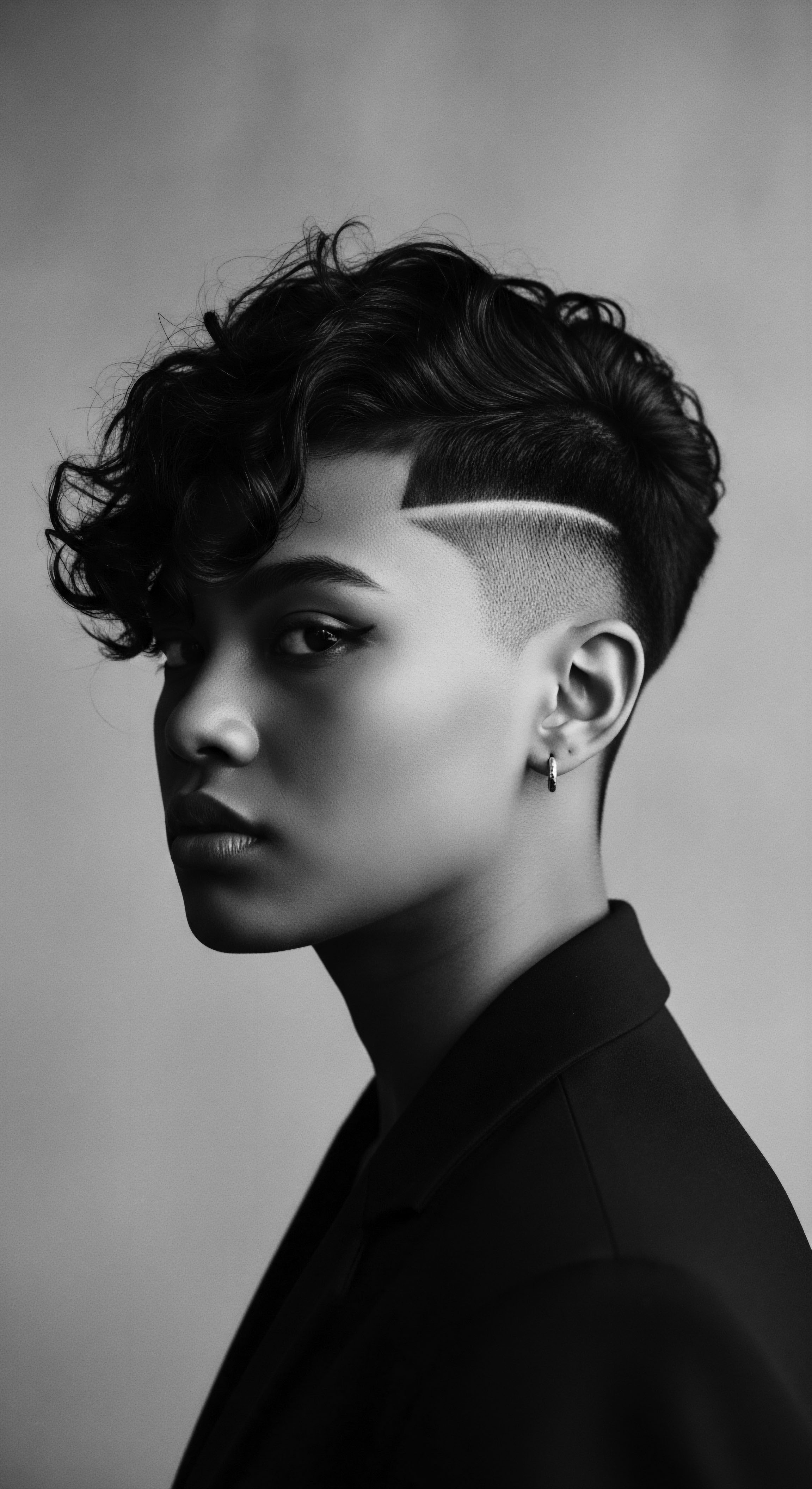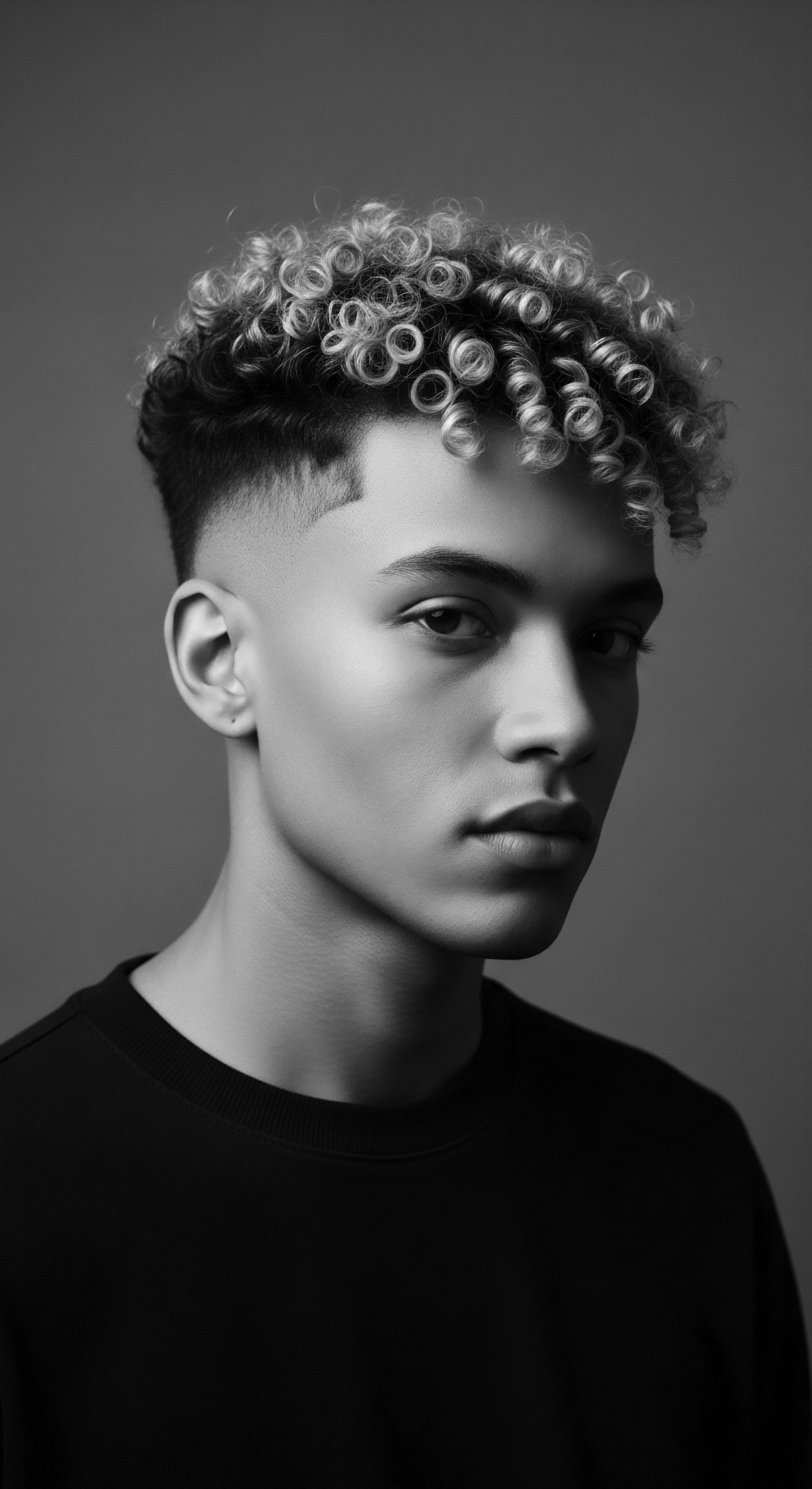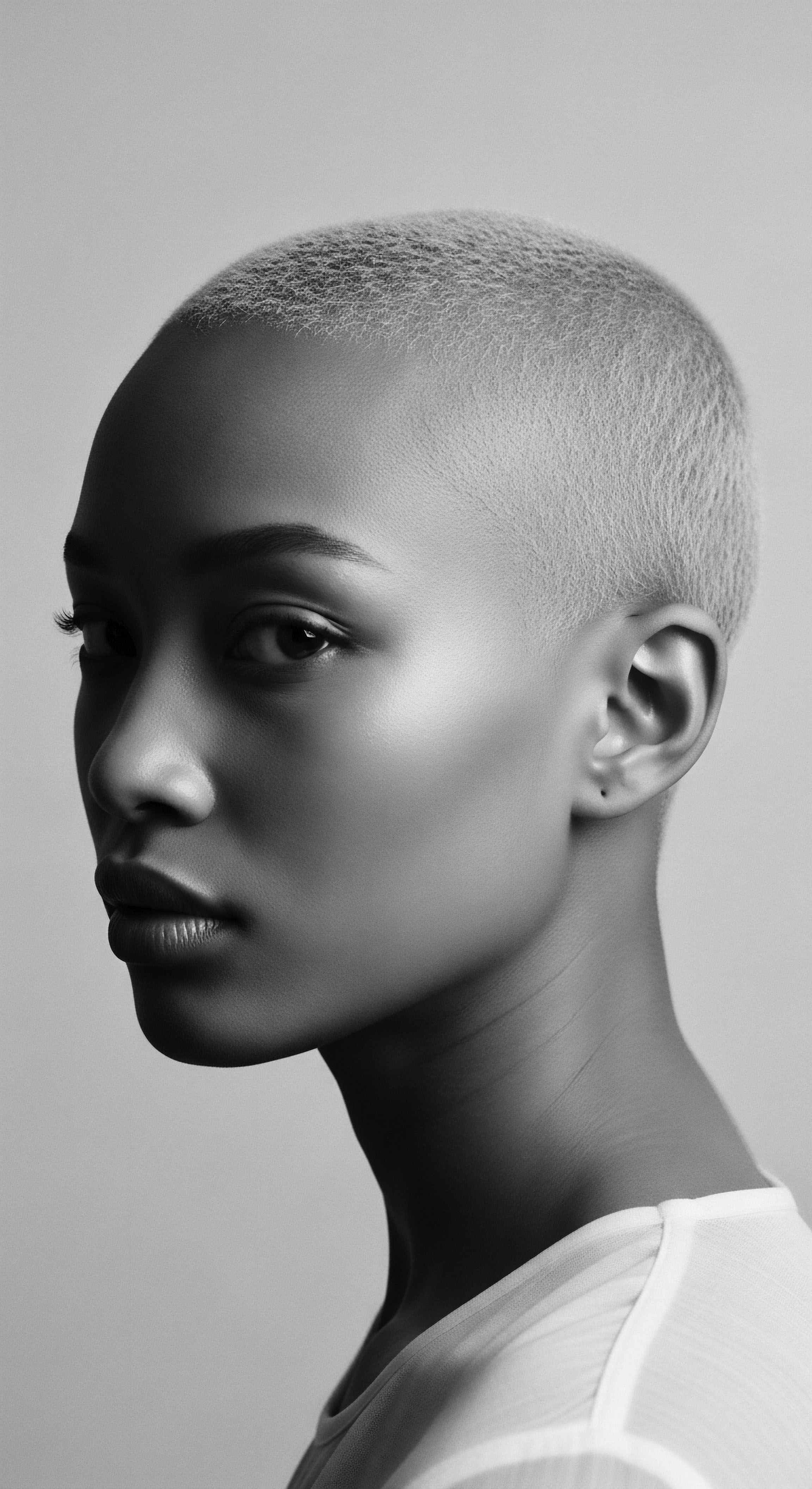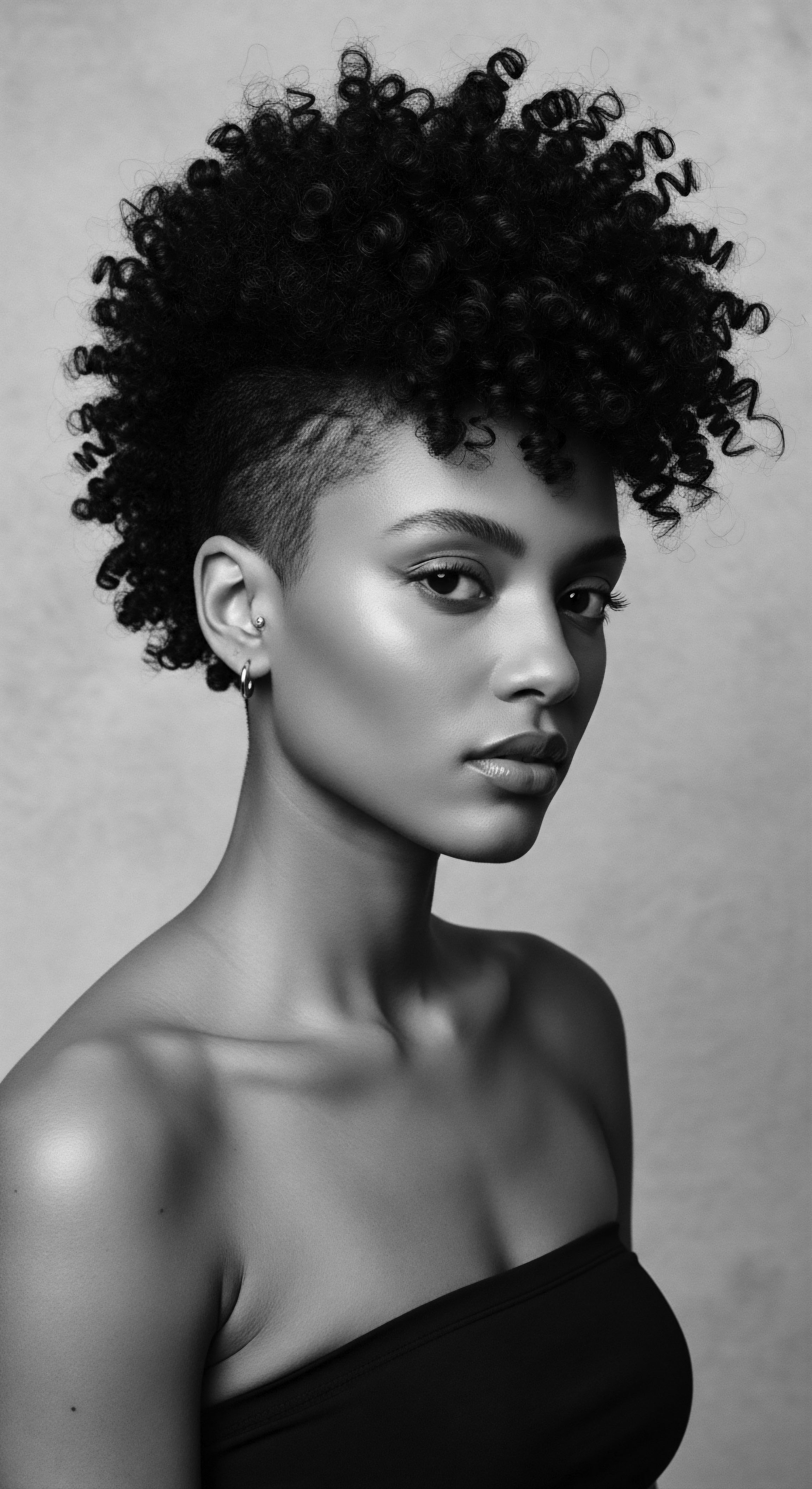
Roots
Consider for a moment the very origins of our being, the deep earth of Africa where humanity first took its breath. Picture the relentless sun, a potent, pervasive force shaping life, bone, and skin. What then, of the hair that crowned our forebears?
Did it simply spring forth as a matter of chance, or did its unique character, its very curl and coil, emerge as a masterful design, a living shield against that ancient, blazing sky? This inquiry guides us to the heart of textured hair heritage, seeking understanding in the elemental biology that binds us to ancestral landscapes.
The architectural marvel of textured hair, particularly those tightly wound coils often seen across African populations, stands as a testament to evolutionary pressures. Scientific consensus suggests that as early hominins adapted to bipedal posture in equatorial Africa, the crown of the head became the primary recipient of direct solar radiation. The brain, a heat-sensitive organ that also generates its own considerable warmth, required protection. Here, the structure of hair enters the story.
Studies, like the compelling work by Lasisi, Smallcombe, Kenney, and their associates in 2023, employing thermal manikins and human hair wigs, revealed how scalp hair significantly lessens heat gain from solar radiation. Notably, hair with tighter curl patterns provides the most effective defense for the scalp against this radiative heat, simultaneously reducing the need for excessive sweat to maintain a balanced temperature. This form, this spiraled wonder, creates a layer of air between the strands and the scalp, allowing for air movement while impeding direct solar penetration.
Textured hair, particularly tightly curled forms, may have served as a natural thermoregulatory adaptation, shielding the brain from intense solar radiation in ancestral African environments.
The fundamental anatomy of textured hair, when viewed through this ancestral lens, acquires an even greater meaning. Unlike straight hair, which tends to lie flat against the scalp, textured hair stands away, creating a canopy. Its cross-sectional shape is often elliptical, and its follicle possesses an asymmetrical, S-like curve. These distinctions contribute to the hair’s inherent volume and lift, providing a natural air buffer.
This architectural ingenuity would have been a survival advantage in environments where consistent overhead sun posed a threat to cerebral overheating. It speaks to a deep connection between human physiology and the challenging, yet life-giving, conditions of the African savanna.

What Did Ancient Hair Structure Offer?
Consider the growth cycles and influencing factors on hair, particularly as they would have played out over millennia in Africa. The constant exposure to intense ultraviolet light and high temperatures exerted immense selective pressure. Hair, alongside skin pigmentation, adapted to address these environmental demands.
Melanin, the pigment that lends hair its color, also acts as a natural absorber of solar radiation, converting it into heat, which the airy structure of textured hair can then dissipate. This biological partnership, of form and pigment, underlines the heritage of protection coded within each strand.
The very composition of textured hair, with its unique distribution of disulfide bonds, contributes to its curl and its protective capabilities. A higher density of these bonds gives textured hair its characteristic tight curves and elasticity. This coiled spring architecture allowed early humans to remain active under the fierce sun, supporting not just physical survival but also the cognitive functions of a rapidly expanding brain.
As Nina Jablonski, an eminent scholar of human adaptation, has observed, the evolution of tightly curled hair might represent a response to new thermoregulatory challenges faced by increasingly encephalized hominins. The brain’s growth, a hallmark of human development, may have been facilitated by the very hair that covered it, a passive defense mechanism against the sun’s radiant energy.
This biological inheritance also finds expression in the ancestral practices of human communities. The Himba people of Namibia, for instance, have long employed a distinctive red ochre paste called otjize, a blend of butterfat, ochre, and aromatic resin, to coat their skin and hair. This traditional mixture, passed down through generations, served not only cultural and aesthetic purposes but also functioned as an early form of sun protection, a physical barrier against the harsh desert sun and insects.
Centuries later, modern science has affirmed the protective qualities of ochre, recognizing its ferrous oxide content as an effective natural sunscreen. This ancestral wisdom, empirically discovered and faithfully practiced, stands as a powerful testament to the deep, historical awareness of sun protection within textured hair heritage.
| Hair Morphology Trait Tightly Curled Structure |
| Evolutionary Advantage in Hot Climates Creates air pockets for insulation and air circulation, reducing direct heat gain from solar radiation. |
| Hair Morphology Trait Hair Standing Away from Scalp |
| Evolutionary Advantage in Hot Climates Reduces heat transfer by conduction and convection, allowing heat to dissipate more easily from the head. |
| Hair Morphology Trait Melanin Pigmentation |
| Evolutionary Advantage in Hot Climates Absorbs UV radiation, acting as a natural protective filter for the scalp. |
| Hair Morphology Trait Minimizes Sweat Need |
| Evolutionary Advantage in Hot Climates Lessens water loss by reducing solar heat influx, crucial for hydration in arid environments. |
| Hair Morphology Trait The form and function of textured hair are intrinsically connected to ancestral environments, a legacy of protection. |
Understanding the fundamental ways in which textured hair is designed to meet environmental challenges grounds our appreciation for its heritage. It is a story not just of superficial appearance, but of deep biological wisdom, of ingenuity written into the very fibers of our being, a legacy from the time when human life itself depended on such adaptations.

Ritual
From the very biological scaffolding of textured hair, our journey extends into the human spirit’s boundless capacity for expression, protection, and meaning through hair. The history of textured hair styling is a vibrant chronicle of adaptability and artistry, intimately tied to the environmental realities and cultural expressions of Black and mixed-race communities throughout time. These are not merely fashion statements; they are living archives, techniques passed down, often rooted in the need to shield and sustain.
Consider the lexicon of protective styling ❉ braids, twists, cornrows, and wraps. These are not inventions of recent times; their ancestry spans millennia, speaking to practical needs and communal bonds. In ancient African civilizations, elaborate braided and twisted styles were signatures of identity, status, and cultural affiliation.
These communal styling sessions, often involving natural butters and botanical blends, served a dual purpose ❉ they preserved the hair’s health against the drying winds and fierce sun, even as they conveyed rich social information. The very act of gathering, of hands working on heads, created community and reinforced shared wisdom.

How Did Styling Protect Hair?
The traditional methods of styling were ingenious responses to living under conditions of constant solar exposure. Imagine women in West Africa, their fingers deftly arranging strands into intricate patterns, each design a deliberate act of care.
- Braids ❉ Tightly woven structures that encase individual hair strands, reducing exposure to environmental elements, including the sun’s direct rays, and minimizing mechanical manipulation.
- Twists ❉ Two-strand or three-strand twists that coil hair upon itself, offering similar protection to braids while retaining moisture.
- Head Wraps ❉ Though sometimes born from necessity during periods of hardship, wraps also served as a versatile and stylish way to cover hair, offering significant sun protection and prolonging styles between washes.
These practices illustrate a profound ancestral understanding of hair health, long before modern scientific terms were coined. The techniques inherently minimized tangling, breakage, and moisture loss, challenges exacerbated by environmental stressors like sun and wind. The styles themselves provided a physical barrier, a form of natural headwear that worked in tandem with the hair’s inherent curl to reduce solar radiation on the scalp.
The cultural significance of these styles deepened over time, particularly during eras of profound upheaval. During the transatlantic trade, the forced shaving of heads was a deliberate act of dehumanization, a cruel attempt to strip away identity and connection to heritage. Yet, even in the face of such brutality, the drive to maintain these hair practices endured.
Enslaved people, stripped of traditional tools and ingredients, adapted with remarkable ingenuity, using whatever was at hand – from bacon grease to cornmeal – to care for their hair and shield it from the elements while toiling under the sun. Head wraps, in particular, transcended their initial practical function to become symbols of quiet defiance and dignity, a means of preserving a cultural tie to identity even when overt displays were suppressed.
The narrative of hair tools also follows this continuum of protection and cultural practice. Traditional combs, often made from wood or bone, were designed to gently navigate the tightly coiled textures, minimizing stress on the delicate strands. These tools were not just implements; they were often symbols, sometimes carved with spiritual motifs, connecting the physical act of hair care to a larger spiritual and communal world. The knowledge of how to use these tools, and how to create these protective styles, was passed from elder to youth, a whisper of wisdom across generations, a living curriculum in the art of hair.
Ancestral styling techniques, deeply rooted in Black and mixed-race heritage, provided crucial sun protection and preserved hair health through ingenious design and communal practice.
Consider the evolution of natural styling techniques. The affirmation of natural hair in the mid-20th century, spurred by movements that championed Black identity and beauty, saw a resurgence and reinvention of these ancestral practices. The Afro, a powerful emblem of self-acceptance, maximized the hair’s natural volume, which, as we discussed, inherently offered a degree of solar protection. This was a reclamation, a public declaration of the beauty and power of textured hair, directly challenging Eurocentric beauty standards that had long denigrated natural curls and coils.
Today, the dialogue around styling continues to draw from this deep wellspring of heritage. Whether it is the conscious choice of a protective style for hair health or the symbolic choice of a particular aesthetic for self-expression, the echoes of ancestral practices remain. The artistry and science of textured hair styling are inseparable from the journey of Black and mixed-race people, a continuous story of adaptation, survival, and profound beauty.

Relay
The journey of textured hair, from its evolutionary beginnings as a safeguard against the sun, extends into the ongoing, daily acts of care that are themselves a living testament to ancestral wisdom. The regimen of radiance, particularly the attention paid to holistic wellbeing and nighttime rituals, offers a profound connection to the heritage of hair care, showing how past solutions continue to resonate in contemporary practices.
Building a regimen for textured hair often means drawing from a rich ancestral knowledge base. Long before chemical compounds and laboratory formulations, communities utilized the natural world around them to nourish and shield their hair. Ingredients like Shea Butter, a staple in West African communities, were not chosen merely for their softening qualities.
They were recognized for their moisturizing and healing properties, acting as a balm against environmental stressors, including sun exposure. Similarly, oils extracted from indigenous plants were revered for their ability to seal moisture and provide a natural sheen, creating a subtle barrier on the hair shaft.

How Does Ancestral Wisdom Inform Modern Hair Care?
The understanding of hair’s needs, particularly for those with textured strands, was intuitively grasped by our forebears. They understood that consistent moisture and gentle handling were paramount. This ancestral insight, honed over generations, now finds validation in modern scientific understanding, which confirms the unique lipid composition and structural fragility of textured hair that requires specialized attention. The traditional reliance on natural substances aligns with contemporary wellness philosophies that seek a harmonious connection with nature.
Consider the nighttime sanctuary, a practice often overlooked in casual discussions of hair care. The bonnet, the scarf, the gentle wrap of hair before sleep, these are not recent inventions; they are continuations of practices that date back centuries. During the era of enslavement, when access to hair care products and time for elaborate styling was severely limited, head wraps served a vital role in protecting hair from damage during labor and prolonged styles. This protective measure evolved into a cultural practice, safeguarding delicate strands from the friction of sleep, preserving moisture, and maintaining integrity.
It speaks to a deep, practical wisdom passed through generations, a silent agreement to preserve what was sacred and vulnerable. The act of wrapping hair at night is a tender ritual, a quiet honoring of the strand’s resilience, echoing the protective instincts of those who came before us.
The compendium of textured hair problem-solving also benefits from this heritage lens. Issues like dryness, breakage, and environmental damage, which are inherent challenges for hair exposed to harsh climates, were addressed through consistent application of moisturizing agents and protective styles. The emphasis was on prevention and restoration, using natural remedies.
- Natural Oils ❉ Historically used to lubricate the hair shaft, reducing friction and aiding in moisture retention, which in turn helped mitigate sun-induced dryness.
- Herbal Infusions ❉ Plants with known medicinal properties were steeped to create rinses that soothed the scalp, promoted health, and offered a cleansing ritual.
- Clay Masks ❉ Certain clays, rich in minerals, were applied to cleanse the scalp and hair, drawing out impurities while providing beneficial nutrients.
These solutions were often communal, shared within families and communities, reinforcing the collective nature of hair care and wellness. The knowledge was lived, breathed, and applied.
Holistic influences on hair health, deeply tied to ancestral wellness philosophies, viewed hair not as an isolated appendage, but as an integral part of the whole self. This perspective understood that diet, spiritual peace, and environmental balance all contributed to a person’s vitality, including the health of their hair. The idea that outer radiance reflects inner harmony is a concept deeply embedded in many indigenous African worldviews. This comprehensive approach to wellbeing, where the mind, body, and spirit are intertwined, elevates hair care beyond mere cosmetic concern to a sacred practice, a daily acknowledgment of one’s heritage and connection to the earth.
Daily textured hair care, from ancestral oils to protective nighttime wraps, embodies a living heritage of solutions crafted for health and resilience under challenging climates.
The science now often explains what ancestral wisdom practiced intuitively. The elliptical cross-section of textured hair, for instance, makes it more prone to breakage if not handled gently, a fact deeply understood in traditional detangling and styling methods. The need for consistent moisture, so central to ancestral care, is underscored by modern understanding of hair’s porous nature. The relay of this knowledge, from generation to generation, ensures that the protective legacy of textured hair continues, adapting and affirming its importance in our present lives.

Reflection
To truly consider whether textured hair evolved for sun protection is to move beyond a simple scientific question; it is to witness a profound, living archive. Each coil, each curve, each tightly wound strand bears the silent echoes of landscapes and journeys, of the persistent sun on ancestral skin. The collective wisdom of Black and mixed-race communities, passed down through the ages, affirms that hair is far more than a biological artifact. It is a heritage.
The story of textured hair is one of inherent brilliance, a testament to the body’s capacity for adaptation in the face of environmental challenge. From the scientific evidence suggesting its role in thermoregulation for early hominins, to the ingenious protective styles and nourishing rituals born from communal knowledge, the thread of preservation runs clear. This hair, in its myriad forms, has weathered not only the elements but also centuries of misunderstanding and imposed standards, emerging always, with resilience.
To honor textured hair is to honor this deep past, to recognize the brilliance of ancestors who understood the needs of their bodies and the gifts of their environment. It is to acknowledge the sacred wisdom embedded in traditions of care, in the careful application of natural oils, in the gentle crafting of protective styles, and in the quiet nightly ritual of preparation. This awareness allows us to step into a future where textured hair is celebrated not just for its aesthetic beauty, but for its profound biological and cultural legacy, a true soul of a strand.

References
- Lasisi, T. Smallcombe, J. W. Kenney, W. L. & Jablonski, N. G. (2023). Human scalp hair as a thermoregulatory adaptation. Proceedings of the National Academy of Sciences of the United States of America, 120(24), e2301760120.
- Jablonski, N. G. & Chaplin, G. (2014). The evolution of skin pigmentation and hair texture in people of African ancestry. Annals of Human Biology, 41(5), 419–422.
- Zhao, C. Wang, Z. Li, Y. Wu, D. Zhang, B. Li, X. & Yu, S. (2024). Adaptive cooling strategy via human hair ❉ High optothermal conversion efficiency of solar radiation into thermal dissipation. Proceedings of the National Academy of Sciences of the United States of America, 121(5), e2318049121.
